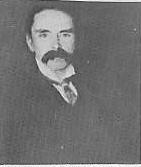1860
1949
Douglas Hyde was born in Castlerea
in County Roscommonon 17 January 1860 he was the youngest son of
the local Church of Ireland rector of Tibohine, Arthur Hyde. From
1867 he lived at Rathra House, a few miles from Ballaghaderreen
in the valley of the River Lung. The young Douglas no doubt led
an idealistic lifestyle in rural Roscommon, during this time he
met and made friends with locals such as Seamus Hart, Mrs. Connolly
and John Lavin who taught him Irish and no doubt instilled in him
a love of Irish culture.
It was expected that Douglas
 would follow
his father into the ministry, but Douglas was more inclined towards
academic subjects, he attended Trinity College where he became fluent
in French, Latin, German, Greek and Hebrew. As a child and young
man he had been fascinated by the the Irish spoken by the older
people in his locality, a language which had been and still was
looked down upon and actively discouraged, Hyde developed a passion
for the language, this passion led to the formation of the Gaelic
League (Conradh na Gaeilge), which was an attempt to save the language
from extinction. would follow
his father into the ministry, but Douglas was more inclined towards
academic subjects, he attended Trinity College where he became fluent
in French, Latin, German, Greek and Hebrew. As a child and young
man he had been fascinated by the the Irish spoken by the older
people in his locality, a language which had been and still was
looked down upon and actively discouraged, Hyde developed a passion
for the language, this passion led to the formation of the Gaelic
League (Conradh na Gaeilge), which was an attempt to save the language
from extinction.
Many of the emerging political
figures of the time such as Michael Collins,
Patrick Pearse, Eamon de Valera and Earnest
Blythe, were influenced and impassioned by the Gaelic League. As
time progressed the League was infiltrated by members of the Irish
Republican Brotherhood, Hyde became unhappy with the radical policies
advocated by some of the new members and resigned as president in
1915. He was replaced by Patrick Pearse
Hyde had no connections with
Sinn Féin and the movement for independence, however he was
appointed to Seanad Éireann, the upper house of the Irish
parliament. In late 1925 the house moved from an appointment system
to one of election. Hyde contested the election, but was a victim
of a smear campaign organized by the far right Catholic Truth Society,
basing their campaign incorrectly, on their perception of Hyde's
support for divorce, and also on his Protestantism, Hyde was not
elected and retired to academic life as Professor of Irish at University
College Dublin.
By April 1938 Hyde was retired,
but once again entered the political arena again when the Taoiseach
Éamon de Valera n appointed Hyde to Seanad Éireann.
He was destined to hold the post for an even shorter time than previously,
it was decided to appoint Ireland's first President and Hyde was
chosen as the most suitable candidate.
Hyde proved to be a popular
choice both at home and abroad in USA President Franklin D. Roosevelt
called President Hyde "A fine and scholarly old gentleman"
Hyde was an avid stamp collector and is said to have corresponded
with King George VI about the subject. In June 1938 Hyde was inaugurated
as the first President of Ireland and moved into the Vice regal
Lodge. Hyde recited the Presidential Declaration of Office in his
native Roscommon Irish dialect. It remains one of the few recordings
of a dialect that has long disappeared.
In April 1940 he suffered a
massive stroke, but to everyone's surprise recovered although confined
to a wheelchair. Rumours abounded about Hyde's mental state, some
saying he was senile,
Douglas Hyde died at 12 pm on
12th July 1949 and as a former President of Ireland he was accorded
a state funeral. One protocol problem that was to arise was Hyde's
Protestant religion. He was to be buries in St Patrick's Church
of Ireland cathedral in Dublin. Religious rules prohibited Roman
Catholics from attending serviced in Protestant churches. Only one
member of the Irish parliament Dr. Noel Browne attended the service
the others remained outside while the funeral service took place
|

 would follow
his father into the ministry, but Douglas was more inclined towards
academic subjects, he attended Trinity College where he became fluent
in French, Latin, German, Greek and Hebrew. As a child and young
man he had been fascinated by the the Irish spoken by the older
people in his locality, a language which had been and still was
looked down upon and actively discouraged, Hyde developed a passion
for the language, this passion led to the formation of the Gaelic
League (Conradh na Gaeilge), which was an attempt to save the language
from extinction.
would follow
his father into the ministry, but Douglas was more inclined towards
academic subjects, he attended Trinity College where he became fluent
in French, Latin, German, Greek and Hebrew. As a child and young
man he had been fascinated by the the Irish spoken by the older
people in his locality, a language which had been and still was
looked down upon and actively discouraged, Hyde developed a passion
for the language, this passion led to the formation of the Gaelic
League (Conradh na Gaeilge), which was an attempt to save the language
from extinction.